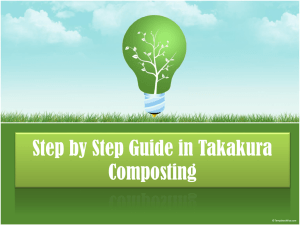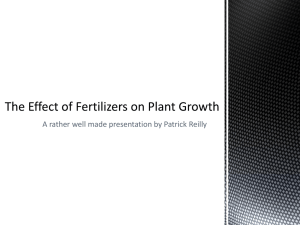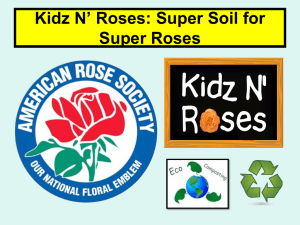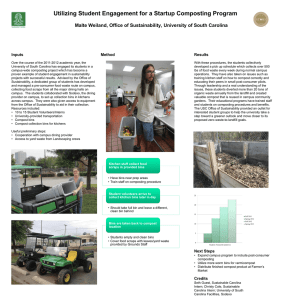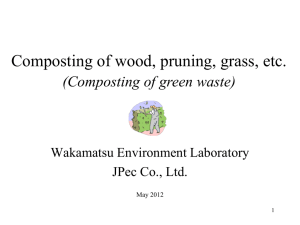(Tg) of CO 2 ey -1
advertisement
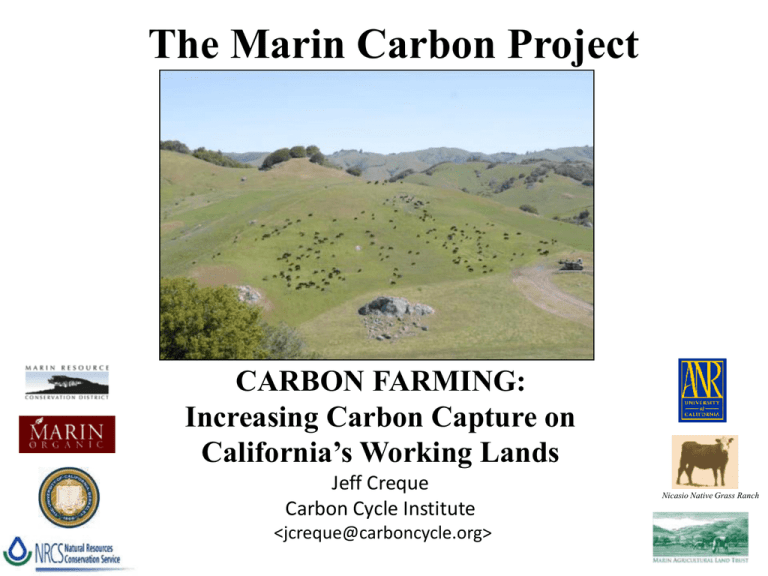
The Marin Carbon Project CARBON FARMING: Increasing Carbon Capture on California’s Working Lands Jeff Creque Carbon Cycle Institute <jcreque@carboncycle.org> Nicasio Native Grass Ranch The Global Challenge for Agriculture Atmospheric CO 2 (ppmv) 400 390 380 370 360 350 340 330 320 310 Year Remember van Helmont’s Willow? 479 Measured effect of deviation-amplifying positive feedbacks resulting from anthropogenic forcing of atmospheric C, with hypothetical effect of deviation-amplifying positive feedbacks resulting from soil organic C increases at global scale “T” factor: managing for equilibrium Annually, 1.8 billion tons of soil are lost from cropland. 120 million acres of cropland are eroding at a rate greater than T. (NRCS 2011). C factor: managing for change (and help stop climate destabilization) If all cropland were managed for C (SCI>0), US soil loss would decline by at least 1.29 billion tons, NRCS, 2011. (at 1% SOC, that is 12.9 M tons of C, or 47 MT CO2e/yr). (SCI = Soil Conditioning Index) “The most practical way to enhance soil health today is to promote better management of soil organic matter or carbon. In short, we should go beyond T (tolerable soil loss) and manage for C (carbon)…” NRCS, 2011 http://soils.usda.gov/sqi/concepts/soil_organic_matter/som.html Can management measurably increase soil carbon; and what happens if we succeed? Results: Above-ground production (forage) has exceeded controls by 40-70% every year following the single ½” compost application in 2008 control compost Aboveground Net Primary Production (g m-2) 1000 750 500 250 0 1 2009 2 2010 3 2011 Year 4 2012 Ryals and Silver 2012 Compost increased soil C (above compost C alone) Pre-treatment 2009 2010 2011 Ryals et al. 2013 Models suggest that the C increase effect persists for 30-100 years → Ryals et al 2013 California Rangelands Carbon Sequestration Potential With Compost Additions 23 million hectares (57 million acres) of rangeland in California: 67% (38 million acres) is grasslands and pastures. (Without avoided methane emissions) At a rate of 0.5 Mg C ha-1 y-1 = 28 MMT(Tg) CO2e y-1 At a rate of 1 Mg C ha-1 y-1 = 56 MMT(Tg) CO2e y-1 At a rate of 3 Mg C ha-1 y-1 = 169 MMT (Tg) of CO2e y-1 Units: Mg = Metric ton MMT(Tg)= Million metric tons CO2e = CO2 equivalents •Livestock ~ 15 MMT CO2e y-1 •Commercial/residential ~ 42 MMT CO2e y-1 •Electrical generation ~112 MMT CO2e y-1 Emissions data: CA GHG Inventory 2010 Compost also increased soil moisture…. Soil Volumetric Water Content (%) 50 45 40 35 30 25 20 15 10 compost 5 control 0 Jun 09 Aug 09 Oct 09 Dec 09 Feb 10 Apr 10 Jun 10 Sep 10 Nov 10 UCSFREC, Browns Valley, Ryals and Silver 2013 Carbon Farm Planning and Implementation Implementation Activities • Identify demonstration C-Farms and conduct farm assessments, including soil sampling (2013). • Apply compost on rangelands at scale (2013) • Develop list of other carbon beneficial NRCS practices, plus; • Complete 3 C-Farm Action Plans • Calibrate GHG accounting models with COMET-Farm/CSU and C-Farm data. • Provide C-Farm permit assistance, technical expertise, implementation funding and monitoring assistance. • Implement C-Farming workshops for farmers and ranchers (2015) • Confirm roles of project partners and scalability to other counties. Quantifying C-Farm Impacts The COMET-Farm Tool (http://cometfarm.nrel.colostate.edu) has potential to allow a relatively rapid and thorough assessment of the greenhouse gas benefits of Integrated Carbon Farms Working with CSU’s NREL to use and refine the methods and models behind the COMET-Farm tool to: 1)calculate the greenhouse gas benefits of proposed practices for our three demonstration carbon farms and; 2)Develop a rapid-assessment on-farm conservation practice carbon capture planning tool: COMET-Planner Tool (http://comet-planner.nrel.colostate.edu) Three of 21 land management practices currently being applied on three carbon farms in Marin County are being evaluated using COMET-Farm: Utilizing compost in rangeland management to increase production and increase soil organic carbon. Implementing agroforestry systems that meet multiple conservation goals while sequestering atmospheric carbon in woody plants and soils. Implementing conservation grazing strategies to increase plant production and increase soil organic carbon. NB: only added N was accounted for in this scenario; no soil water or soil O2 enhancement from SOM increases was included in the model. Grazing had a synergistic effect with Compost in the model. In this scenario, a site was heavily grazed from 1880- 2012. At 2013, grazing became moderate, and fertilizer or compost (or control) was applied. This scenario illustrates the synergistic effect of “stacking” C-beneficial practices in the C-Farm context. Marin County Carbon Farm Planning NRCS Practices Critical Area Planting (342) Riparian Herbaceous Cover (390) Riparian Forest Buffer (391) Forage and Biomass Planting (512) Prescribed Grazing (528) Hedgerow Planting/ Windbreak/ Shelterbelt Est. / Vegetative Buffer (422/380/601) Mulching (Compost Application) (484) Range Planting (550) Silvopasture: Establish Trees & Native Grasses (381/612) Anaerobic Digester (366) Nutrient Management (590) Residue and Tillage Management/No–Till system/Strip Till/ Direct Seed (329) Filter Strip (393) Streambank Protection (580) Wetland Enhancement (659) Conservation Cover (327) Wetland Restoration (657) Field Boarder (386) Grassed Waterway (412) Alley Cropping (311) Additional NRCS Practices Supportive of On-Farm Carbon-Sequestration in Marin Compost Facility (317) Fencing / Access Control (382/ 472) Grazing Management Plan (110) Water Development: Livestock Pipeline/ Water Facility (516,614) Structure for Water Control (587) Grade Stabilization Structures (410) Comprehensive Nutrient Management Plan Potential Revenue Sources for Rangeland Compost Practice State Incentives Federal Conservation Funds Carbon Market ($15/ton) Supply Chain and Cost Savings CEQA and Local GHG Mitigation We have developed a market protocol for compost application to rangelands, approved by American Carbon Registry and under review by BAAQMD Policy and Economic Supports for Carbon Farming Regional BAAQMD: Approval of Rangeland Compost Protocol for CEQA+ State ARB AB32 Scoping Plan Update CalRecycle Waste Sector Plan (compost incentives) Natural Resources Agency (Natural and Working Lands) Bay Area IRWMP: 2014+ Priorities (Climate) AB32 Cap and Trade Program Approval of Rangeland Compost Protocol Investment Plan Rangeland Compost Protocol American Carbon Registry CAPCOA Bay Area Regional Climate Adaptation Natural Resources Agency: Climate Adaptation Proportion of Costs Associated with Compost Application Total Cost of $40.00/ton Monitoring before Compost Addition 5% Monitoring after 5% Costs of Other Climate Mitigation Strategies: Project Validation 13% Alternative Transportation (bike lanes) $109.80/ton Energy Conservation $121.04/ton Solar PV $344.46-562.50/ton Compost Addition 51% GHG Offset Assertion 18% (Napa County Planning Division, 2012) Securing Credits 8% Questions? www.marincarbonproject.org Photo: http://restlesspilgrim.net

